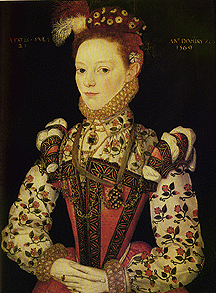
This girl is wearing typical clothing of the late 16th century. Her bodice is a dark orange color, or "orange tawney" as people of the time would have called it, descends to a point in the front. Her skirt flares out sharply at the hips, aided by a bumroll.
This outfit is different in a number of ways from the typically "tudor" garb worn during the first half of the century. One of the most noticeable differences is the type of sleeve worn with the gown: gone are the bell-shaped oversleeves and the large, elaborate undersleeve. It has been replaced by a modestly-sized and richly-embroidered sleeve. The large puffs at the shoulders, another new addition to fashion, most likely hide the points by which the sleeve is attatched to the bodice. The separation of sleeves and bodice is a hallmark of elizabethan dress.
The girl's chest is covered by a partlet matching the sleeves; partlets were originally worn over the bodice and tied underneath the arms, but by this time they were worn inside the bodice and primarily decorative. They also provided a neck band to attatch a ruff to. Younger girls would wear their partlet open in the front, as this girl does, while married women would usually wear theirs closed.
Although most matching sleeves and partlets were separate garments, it is possible that in this case the girl is wearing one blouse-like garment underneath her bodice. A picture of such a garment can be seen in the portrait of Queen Elizabeth and the Three Graces, but this is the sole iconographical evidence.
Another new addition to women's dress is apparant in this picture: the ruff, which will forever be associated with Elizabethan costume. At this point in time, it is relatively modest; but as the century progresses, so does the size of the neck ruff. Note the matching ruffs at the wrists; Detatchable wrist ruffs, the style of which matched the ruff at the neck, were also worn.
Finally, the headdress is very different from that worn by Jane Dudley. Much more hair is exposed to view, and an elaborate hat is perched atop her coiffure. Her hair, rather than being parted in the middle and smoothly pulled down to each side and then back, is pulled straight back from her forehead and is fashionably wavy. Women and men's headwear became more generally exchangeable during the late 16th century; both sexes wore flat caps and taller hats, though the coif and veil continued to be worn by women alone.
Next: Fashion on the Streets of London